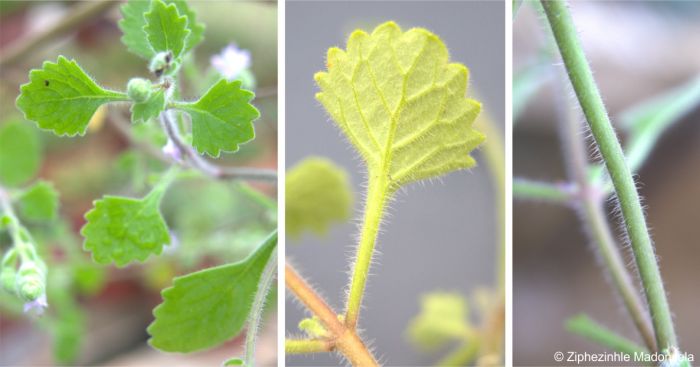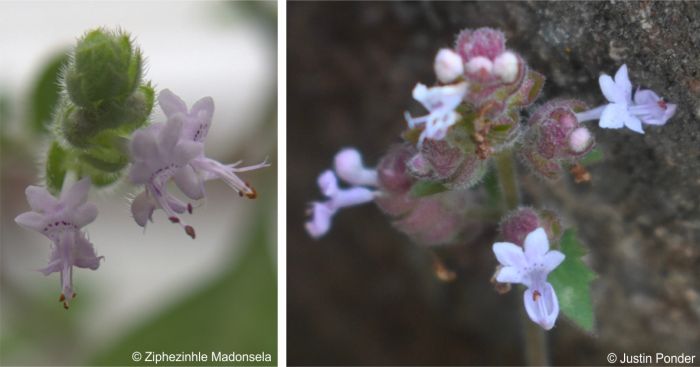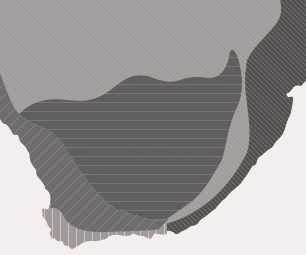Aeollanthus buchnerianus
Aeollanthus buchnerianus Briq.
Family: Lamiaceae
Common names: crevice sage, Buchner’s rock sage, radiant rocksage (Eng.), klipsalie, klipskeusalie (Afr.), thokoloane, thokolwane (Sesotho)
Introduction
Aeollanthus buchnerianus is an aromatic herbaceous semi-succulent shrub with unique chemicals, medicinal properties and is an attractive feature plant for herb gardens.

Description
Description
Aeollanthus buchnerianus is a soft semi-succulent herbaceous shrub that is 150–500 mm tall, with upright (erect) or spreading stems that are greyish green and velvety, often with scattered longish hairs. Leaves have stalks (petioles) that are 15-40 mm long, attaching them to the stem. The leaves are ovate, rounded and shaped like an egg, and the leaf edges (margins) are dentate. The upper side of the leaves is nearly smooth to covered in short hairs, and the under side has raised veins.

The inflorescence forms at the ends of the stems. Flowers appear singly or in pairs mostly during summer and throughout autumn. Flowers are light violet, pink or whitish and they are wide open towards the throat. The corolla has vertical dot-like markings, that are a darker shade of colour of the lobe. The upper lip has 4 spreading lobes while the lower lip is shaped like a boat that is hooded with 2 bent back lobes at the base. At the beginning, the lips are fused together and straight, with anthers hidden inside the hood, but it opens up by bending backwards and the stamens are exposed. Stamens are inserted tightly beside each other near the opening of the corolla tube. The bracts are broadly ovate, overlapping and are rounded or slightly pointed at the tip. Fruits are nutlets that are smooth and glossy, formed inside the calyx and released as they open up horizontally.

Conservation Status
Status
Aeollanthus buchnerianus is assessed as Least Concern (LC) by the Red List of South African Plants. It is widely distributed, not threatened in its natural habitat and not in danger of extinction.
Distribution and habitat
Distribution description
Aeollanthus buchnerianus is a widely distributed plant. In South Africa it grows naturally in Eastern Cape, Free State, Gauteng, KwaZulu-Natal, Limpopo, Mpumalanga and North West, and these are predominantly the summer-rainfall provinces of South Africa. It is also indigenous in southern Africa and tropical Africa occuring in countries including Angola, Congo and Tanzania. It grows in shallow soil pockets among rocks and prefers semi-shaded and sometimes humid places. In Limpopo and Mpumalanga, the northern provinces of South Africa, this plant grows at higher elevations.
Derivation of name and historical aspects
History
Aeollanthus buchnerianus is the name this plant was given by John Isaac Briquet in 1894. The genus Aeollanthus was named in 1825 by Christian Konrad Sprengel who was a German botanist, from the plant that was collected by Dr. Ph Martius. The name Aeollanthus is derived from Greek aiolos meaning the god of wind, and -anthos means flower. This species is named after J.G. Buchner, a German naturalist who collected the type specimen in Angola.
There are about 45 species of Aeollanthus that all grow naturally in Africa, and Aeollanthus buchnerianus is one of the 8 species that occur in southern Africa. This plant belongs to the Lamiaceae family, along with Coleus, Ocimum, Plectranthus and Tetradenia species. Many species from this family are cultivated for medicinal, culinary or ornamental purposes. It is believed that there are about 100 species of Aeollanthus distributed in sub-saharan Africa excluding Madagascar, however only about 45 have been described. The South African species, Aeollanthus parvifolius, is known for thriving even in harsh conditions, and other species, such as Aeollanthus suaveolens, are known for their fragrance and medicinal properties.
Recent research shows that Aeollanthus buchnerianus has distinct characteristics and possesses compounds known for diverse biological activities that have anti-inflammatory, anti-tumoral, and antifungal properties. It shares these characteristics with Tetradenia species rather than Plectranthus species, which was unexpected. During the study on the chemical compounds that this plant possesses, it was found to contain 11 chemicals that had never been reported in any plant, and these compounds provide insights regarding the relationship between this plant and other plants in the Lamiaceae family.

Ecology
Ecology
Aeollanthus buchnerianus has the ability to survive in harsh conditions, such as hot temperatures and drought, due to the plant being semi-succulent, whichgives this plant ability to store water and food for longer periods. Similar to other Aeollanthus species such as A. haumannii, A. rydingianus and A. parvifolius, it is highly aromatic and has sticky leaves, that protect it from herbivores. Seeds are able to survive and grow on shallow soils of various nature and establish themselves among rocks and in rock crevices.
Uses
Use
Aeollanthus buchnerianus is mostly used as a garden plant, as it makes a beautiful feature plant in herb gardens and on the borders of flowerbeds, and its beautiful flowers bring a welcome pop of colour in summer and early autumn. It also helps with repelling insects in the garden.
The Southern Sotho people of South Africa use this plant for traditional medicine as a cold remedy for children. Leaves are smoked during the management of common cold.
Growing Aeollanthus buchnerianus
Grow
Aeollanthus buchnerianus is a very easy plant to grow. It needs well-drained soil, and grows well in a semi-shaded position in the garden, although it tolerates a bit of full sun but not for the entire day, and too much shade can disturb the growth and development of the plant. Warm to hot temperatures are ideal for this plant to thrive. It doesn’t do well in cold and frosty conditions. It requires regular pruning every now and then as it can spread rapidly and get out of control if it not monitored. It grows in various types of soils such as clay, loam, rocky and sandy soil mixed with compost, provided that the soil is well-drained.
Aeollanthus buchnerianus is propagated from seeds and cuttings. Asexual propagation through cuttings is the easiest method. This plant can be propagated from stem cuttings throughout the year especially in provinces such as Mpumalanga and Limpopo where the temperatures are mostly warm for the majority of the year.
Cuttings collected from the wild are able to survive for longer periods due to the plant being a semi-succulent, keep them in a plastic bag and sprinkle with water, even without plant hormone regulators they can survive up to 5 days before they are propagated. Cuttings should be planted in a well-drained medium, until it has roots. It can then be transplanted to potting bags with 3 parts compost and 1 part of river sand. It roots easily even without a rooting hormone.
Pests such as aphids and milkweed grasshoppers can affect the plant. Aphids can be controlled by using insecticide, neem oil or by pruning off the infected area, ensure that the pruned off part is destroyed immediately. In Lowveld National Botanical Garden, this plant species has been spotted being infested by Dictyophorus spumans (Koppie Foam Grasshoppers).
References
- Attwood, S. 2024-Feb. Observation of Aeollanthus buchnerianus, Ehlanzeni, Mpumalanga. iNaturalist. Online. https://www.inaturalist.org/observations/198405298.
- Bihrmann’s Caudiciforms. Aeollanthus buchnerianus. https://bihrmann.com/caudiciforms/SUBS/aeo-buc-sub.asp. Accessed 7 May 2025.
- Bitchagno, G.T., Reynolds, N. & Simmonds, M.S. 2025. Diterpene chemical space of Aeollanthus buchnerianus Briq. aerial part. Natural Products and Bioprospecting 15(1):6.
- Bvenura, C. & Kambizi, L. 2023. Sustainable uses and prospects of medicinal plants. CRC Press, United Kingdom.
- Eggli, U. (ed). 2002. Illustrated handbook of succulent plants: Dicotyledons. Springer, Berlin.
- Germishuizen, G. & Meyer, N.L. (eds) 2003. Plants of southern Africa: an annotated checklist. Strelitzia 14. National Botanical Institute, Pretoria.
- Hankey, A. 2021-Feb. Observation of Aeollanthus buchnerianus, Sedibeng, Gauteng. iNaturalist. Online. https://www.inaturalist.org/observations/70448952.
- Hyde, M.A., Wursten, B.T., Ballings, P. & Coates Palgrave, M. 2025. Aeollanthus buchnerianus. Flora of Zimbabwe. Online. https://www.zimbabweflora.co.zw/speciesdata/species.php?species_id=149580. Accessed 7 May 2025.
- Kirby, G. 2013. Wild flowers of southeast Botswana. Struik, Cape Town.
- Moffett, R. 2016. Basotho medicinal plants / Meriana ya dimela tsa Basotho - Second Edition. SunBonani Scholar, United Kingdom.
- Moffett, R. 2010. Sesotho plant and animal names and plants used by the Basotho. Sun Press, Bloemfontein.
- Plants of the World Online. Aeollanthus buchnerianus Briq. https://powo.science.kew.org/taxon/urn:lsid:ipni.org:names:444384-1/general-information. Accessed 16 Jun 2025.
- Ponder, J. 2025-Apr. Observation of Aeollanthus buchnerianus, Zululand, KwaZulu-Natal. iNaturalist. Online. https://www.inaturalist.org/observations/272391785.
- Rattray, R.D. & Van Wyk, B.E. 2021. The botanical, chemical and ethnobotanical diversity of southern African Lamiaceae. Molecules 26(12):3712.
- Retief, E. & Herman, P.P.J. 1997. Plants of the northern provinces of South Africa: keys and diagnostic characters. Strelitzia 6. National Botanical Institute, Pretoria.
- Van Jaarsveld, E.J. & Van Wyk, A.E. 2005. Notes on African Plants, Lamiaceae, Aeollanthus rydingianus, a new species from northern Namibia and southern Angola. Bothalia 35(2):157–160.
- Van Jaarsveld, E.J. 2013. Waterwise gardening in South Africa and Namibia. Penguin Random House, South Africa.
- Von Staden, L. 2017. Aeollanthus buchnerianus Briq. National Assessment: Red List of South African Plants. https://redlist.sanbi.org/species.php?species=1709-1.
- Wikipedia. Aeollanthus. https://en.wikipedia.org/wiki/Aeollanthus. Accessed 14 May 2025.
Credits
Ziphezinhle Madonsela
Lowveld National Botanical Garden
September 2025
Acknowledgements: the author thanks Simon Attwood, Justin Ponder and Andrew Hankey for providing images for this article, and Pfuluwani Ndou for assistance during the field work and propagation.
Plant Attributes:
Plant Type: Shrub
SA Distribution: Eastern Cape, Free State, Gauteng, KwaZulu-Natal, Limpopo, Mpumalanga, North West
Soil type: Sandy
Flowering season: Late Summer, Autumn
PH: Acid
Flower colour: White, Pink, Mauve/Lilac
Aspect: Full Sun
Gardening skill: Easy
Special Features:
Horticultural zones









Rate this article
Article well written and informative
Rate this plant
Is this an interesting plant?
Login to add your Comment
Back to topNot registered yet? Click here to register.